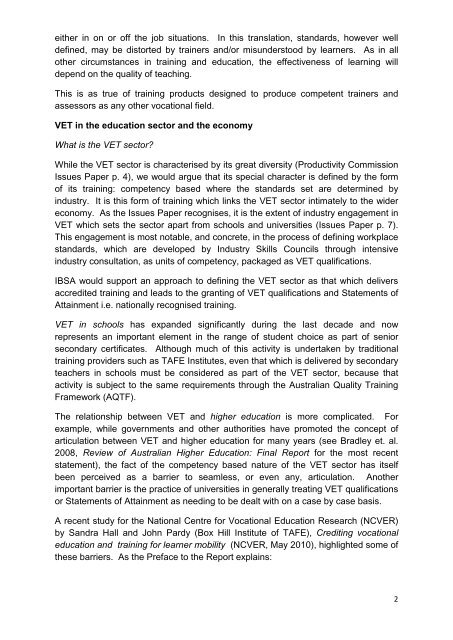Innovation & Business Skills Australia - Productivity Commission
Innovation & Business Skills Australia - Productivity Commission
Innovation & Business Skills Australia - Productivity Commission
You also want an ePaper? Increase the reach of your titles
YUMPU automatically turns print PDFs into web optimized ePapers that Google loves.
either in on or off the job situations. In this translation, standards, however well<br />
defined, may be distorted by trainers and/or misunderstood by learners. As in all<br />
other circumstances in training and education, the effectiveness of learning will<br />
depend on the quality of teaching.<br />
This is as true of training products designed to produce competent trainers and<br />
assessors as any other vocational field.<br />
VET in the education sector and the economy<br />
What is the VET sector?<br />
While the VET sector is characterised by its great diversity (<strong>Productivity</strong> <strong>Commission</strong><br />
Issues Paper p. 4), we would argue that its special character is defined by the form<br />
of its training: competency based where the standards set are determined by<br />
industry. It is this form of training which links the VET sector intimately to the wider<br />
economy. As the Issues Paper recognises, it is the extent of industry engagement in<br />
VET which sets the sector apart from schools and universities (Issues Paper p. 7).<br />
This engagement is most notable, and concrete, in the process of defining workplace<br />
standards, which are developed by Industry <strong>Skills</strong> Councils through intensive<br />
industry consultation, as units of competency, packaged as VET qualifications.<br />
IBSA would support an approach to defining the VET sector as that which delivers<br />
accredited training and leads to the granting of VET qualifications and Statements of<br />
Attainment i.e. nationally recognised training.<br />
VET in schools has expanded significantly during the last decade and now<br />
represents an important element in the range of student choice as part of senior<br />
secondary certificates. Although much of this activity is undertaken by traditional<br />
training providers such as TAFE Institutes, even that which is delivered by secondary<br />
teachers in schools must be considered as part of the VET sector, because that<br />
activity is subject to the same requirements through the <strong>Australia</strong>n Quality Training<br />
Framework (AQTF).<br />
The relationship between VET and higher education is more complicated. For<br />
example, while governments and other authorities have promoted the concept of<br />
articulation between VET and higher education for many years (see Bradley et. al.<br />
2008, Review of <strong>Australia</strong>n Higher Education: Final Report for the most recent<br />
statement), the fact of the competency based nature of the VET sector has itself<br />
been perceived as a barrier to seamless, or even any, articulation. Another<br />
important barrier is the practice of universities in generally treating VET qualifications<br />
or Statements of Attainment as needing to be dealt with on a case by case basis.<br />
A recent study for the National Centre for Vocational Education Research (NCVER)<br />
by Sandra Hall and John Pardy (Box Hill Institute of TAFE), Crediting vocational<br />
education and training for learner mobility (NCVER, May 2010), highlighted some of<br />
these barriers. As the Preface to the Report explains:<br />
2

















